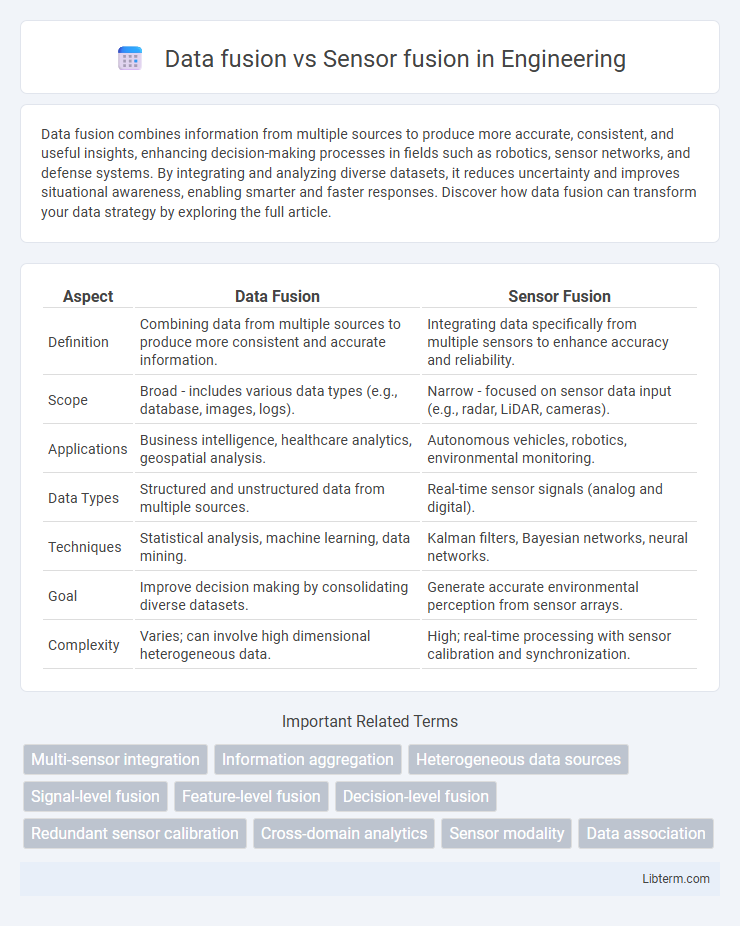Data fusion combines information from multiple sources to produce more accurate, consistent, and useful insights, enhancing decision-making processes in fields such as robotics, sensor networks, and defense systems. By integrating and analyzing diverse datasets, it reduces uncertainty and improves situational awareness, enabling smarter and faster responses. Discover how data fusion can transform your data strategy by exploring the full article.
Table of Comparison
| Aspect | Data Fusion | Sensor Fusion |
|---|---|---|
| Definition | Combining data from multiple sources to produce more consistent and accurate information. | Integrating data specifically from multiple sensors to enhance accuracy and reliability. |
| Scope | Broad - includes various data types (e.g., database, images, logs). | Narrow - focused on sensor data input (e.g., radar, LiDAR, cameras). |
| Applications | Business intelligence, healthcare analytics, geospatial analysis. | Autonomous vehicles, robotics, environmental monitoring. |
| Data Types | Structured and unstructured data from multiple sources. | Real-time sensor signals (analog and digital). |
| Techniques | Statistical analysis, machine learning, data mining. | Kalman filters, Bayesian networks, neural networks. |
| Goal | Improve decision making by consolidating diverse datasets. | Generate accurate environmental perception from sensor arrays. |
| Complexity | Varies; can involve high dimensional heterogeneous data. | High; real-time processing with sensor calibration and synchronization. |
Introduction to Data Fusion and Sensor Fusion
Data fusion integrates data from multiple sources to produce more consistent, accurate, and useful information than that provided by any individual data source alone. Sensor fusion specifically focuses on the combination of sensory data from multiple sensors to improve system reliability and performance in fields such as robotics, autonomous vehicles, and environmental monitoring. Both approaches enhance decision-making processes by leveraging complementary data but differ in scope, with data fusion encompassing broader data types beyond sensors.
Defining Data Fusion: Scope and Applications
Data fusion integrates multiple data sources to produce more consistent, accurate, and useful information than individual data inputs, spanning applications such as remote sensing, robotics, and military surveillance. It encompasses various data types including sensor data, databases, and knowledge bases, enabling comprehensive analysis and decision-making. In contrast, sensor fusion specifically combines raw data from multiple sensors to enhance perception in real-time systems like autonomous vehicles and wearable devices.
Understanding Sensor Fusion: Key Concepts
Sensor fusion integrates data from multiple sensors to produce more accurate, reliable, and comprehensive information than individual sensors alone. Key concepts include data alignment, noise reduction, and complementary data combination, enabling improved perception in applications such as autonomous vehicles and robotics. Understanding sensor fusion involves grasping fusion layers like raw data fusion, feature-level fusion, and decision-level fusion to optimize the overall system performance.
Core Differences Between Data Fusion and Sensor Fusion
Data fusion integrates information from multiple data sources to produce more consistent, accurate, and useful information than that provided by any individual data source, while sensor fusion specifically combines data from multiple sensors to enhance the reliability and accuracy of measurements. The core difference lies in the scope: sensor fusion is a subset of data fusion focused exclusively on merging raw sensor inputs, often in real-time applications such as autonomous vehicles or robotics. Data fusion encompasses a broader range of data types, including processed information, and supports decision-making processes beyond sensor inputs.
Typical Use Cases for Data Fusion
Typical use cases for data fusion include environmental monitoring, where data from multiple sources such as satellite imagery, weather stations, and IoT sensors are integrated to provide comprehensive analysis. In healthcare, data fusion combines patient records, wearable device outputs, and clinical data to enhance diagnosis and treatment plans. Autonomous vehicles rely on data fusion to merge information from GPS, cameras, radar, and lidar for accurate navigation and obstacle detection.
Common Applications of Sensor Fusion
Sensor fusion finds widespread applications in autonomous vehicles, where data from cameras, LiDAR, and radar are combined to enhance object detection and navigation accuracy. In robotics, sensor fusion integrates inputs from accelerometers, gyroscopes, and magnetometers to improve motion tracking and control. Wearable technology also relies on sensor fusion to merge data from heart rate monitors, GPS, and accelerometers for comprehensive health and activity monitoring.
Advantages and Limitations of Data Fusion
Data fusion integrates information from multiple heterogeneous data sources, enhancing decision accuracy and providing a comprehensive understanding beyond what sensor fusion, which combines data primarily from similar types of sensors, can achieve. Advantages of data fusion include improved reliability, reduced uncertainty, and enriched context awareness by leveraging diverse datasets such as images, audio, and textual data. Limitations involve increased computational complexity, challenges in data alignment and synchronization, and potential issues with data quality and compatibility across varied sources.
Benefits and Challenges of Sensor Fusion
Sensor fusion integrates data from multiple sensors to improve accuracy and reliability in applications like autonomous driving and robotics, enhancing situational awareness and decision-making. Benefits include increased robustness against sensor failures, noise reduction, and a more comprehensive understanding of the environment. Challenges involve sensor calibration, data synchronization, handling heterogeneous data formats, and managing computational complexity.
Integration Strategies: Combining Data and Sensor Fusion
Data fusion integrates multiple data sources to enhance information quality, combining diverse datasets such as images, text, and numerical data for comprehensive insights. Sensor fusion specifically merges data from various sensors like cameras, LIDAR, and radar, improving accuracy and reliability in applications such as autonomous vehicles and robotics. Both integration strategies rely on complementary techniques like Kalman filtering, Bayesian networks, and machine learning algorithms to synthesize heterogeneous inputs effectively.
Future Trends in Data and Sensor Fusion Technologies
Future trends in data and sensor fusion technologies emphasize the integration of AI-driven algorithms and edge computing to enhance real-time analytics and decision-making capabilities. Advances in machine learning models enable more accurate interpretation and combination of heterogeneous data sources, improving situational awareness in autonomous systems and IoT applications. The convergence of 5G connectivity with sensor fusion techniques facilitates low-latency data processing, driving innovations in smart cities, healthcare monitoring, and industrial automation.
Data fusion Infographic

 libterm.com
libterm.com